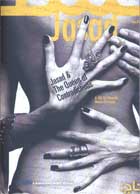
Jasad & The Queen of Contradictions 2011
Distributed by Women Make Movies, 115 W. 29th Street, Suite 1200,New York, NY, 10001; 212-925-0606
Produced by Amanda Homsi-Ottosson, Alan Habeeb
Directed by Amanda Homsi-Ottosson
DVD , color, 40 min.
Sr. High - General Adult
Ethics, Gender Studies, Human Rights, Journalism, Language, Media Studies, Middle Eastern Studies, Multicultural Studies, Photography, Poetry, Political Science, Popular Culture, Religious Studies, Women’s Studies
Date Entered: 07/11/2013
female filmmakers.">Reviewed by Jennifer Dean, Graduate of the CUNY Graduate Center MALS program with thesis on female filmmakers.Jasad & The Queen of Contradictions addresses issues of sexuality in the Arab world through the story of Joumana Haddad, a poet and writer who created a magazine in Lebanon celebrating and exploring the body through art, science and literature. Jasad (the body) uses the letter J in Arabic, an open handcuff, as a symbol of liberation of the female form and language associated with sexuality – specifically the Arabic language. Haddad argues that many Arabic Lebanese may feel comfortable referring to female genitalia in French or English but would never utter similar terms in Arabic and that, despite the appearance of liberalism in Lebanon in relation to other countries in the Middle East, conservative mores still stifle creativity and sexuality. Filmmaker Homsi-Ottosson illustrates these contradictions with footage of billboards and parties filled with scantily clad women, and on the street interviews with various students and young people who insist that they cherish their virginity, and some who are appalled by the representations of nudity and exploration of sexuality in Jasad. She goes beyond the story of the magazine and its maker to address the tradition of reconstruction surgery of the hymen, interviewing a surgeon who reluctantly provides the service. That said, the film would benefit by even further examination of the subject matter of sexuality in Lebanon and the world that Jasad inhabits. At just forty minutes, it only scratches the surface of several complex subjects – linguistics, culture, sexuality, social mores and hypocrisy, and feminism in the Arab world. One scene of the film gives voice to a group of feminists who disagree with Haddad’s publication but that scene is fleeting. Although the acceptance of sexuality in commercial terms but not in artistic terms underlies much of the film (exemplified in a line from a poem that Haddad reads at the end of the film which refers to Lebanon – a country of contradictions – being a place where women can get bank loans for breast enlargement) it could be examined even further. The film is a wonderful primer for further exploration of many different subjects but would benefit from supplemental material – and more than anything is simply the story of an entrepreneur.